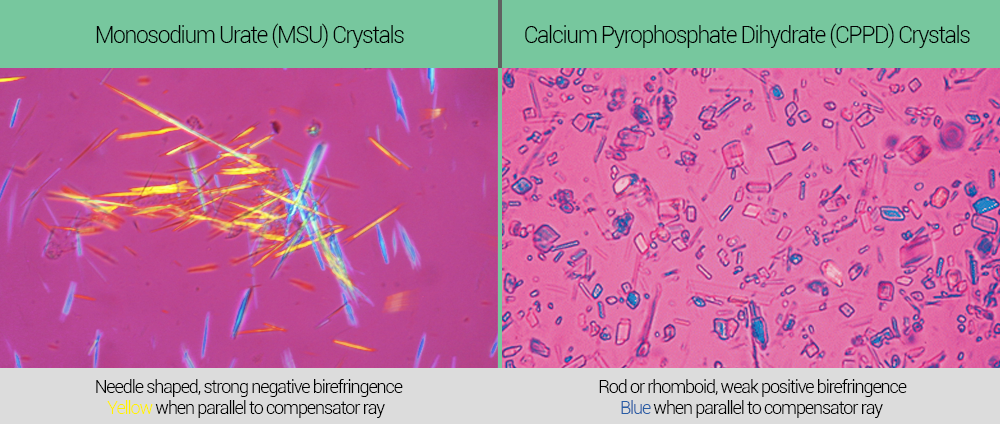WBR0900
Jump to navigation
Jump to search
| Author | [[PageAuthor::Serge Korjian M.D. (Reviewed by Serge Korjian)]] |
|---|---|
| Exam Type | ExamType::USMLE Step 1 |
| Main Category | MainCategory::Pathophysiology |
| Sub Category | SubCategory::Musculoskeletal/Rheumatology |
| Prompt | [[Prompt::A 63-year-old obese man with history of hypertension treated with thiazide diuretics complains of rapidly progressive pain in his big toe. The pain began in the morning and has become much worse in the last 6 hours. On physical exam, the toe is erythematous, swollen and tender to palpation. The patient reports two similar prior episodes that were less painful and resolved spontaneously. Synovial analysis reveals strongly birefringent needle-shaped crystals on polarized light microscopy. Deposition of which of the following most likely explains the symptoms in the patient?]] |
| Answer A | AnswerA::Uric acid |
| Answer A Explanation | AnswerAExp::The presentation of this patient is consistent with gouty arthritis. Hyperproduction or underexcretion of uric acid leads to hyperuricemia predisposing to gout. However, the crystal deposits in gouty arthritis are monosodium urate. |
| Answer B | AnswerB::Monosodium urate |
| Answer B Explanation | AnswerBExp::The presentation of this patient is consistent with gouty arthritis, a condition characterized by deposition of monosodium urate crystals. |
| Answer C | AnswerC::Calcium pyrophosphate dehydrate |
| Answer C Explanation | [[AnswerCExp::Calcium pyrophosphate dihydrate (CPPD) has a similar presentation to gout but it is caused by the accumulation of crystals of calcium pyrophosphate dihydrate in the connective tissues. Pseudogout usually involves larger joints than gout. The presence of rhombus-shaped crystals which are weakly birefringent on polarized light microscopy is diagnostic for pseudogout.]] |
| Answer D | AnswerD::Phosphoribosylpyrophosphate |
| Answer D Explanation | [[AnswerDExp::Increased levels of phosphpribosylpyrophosphate (PRPP) leads to the overproduction and accumulation of uric acid leading to hyperuricemia and hyperuricosuria. Increased levels of PRPP are present in Lesch-Nyhan Syndrome. Decreased levels of hypoxanthine guanine phosphoribosyl transferase (HGPRT) causes this accumulation, as PRPP is a substrate used by HGPRT during purine salvage.]] |
| Answer E | AnswerE::Calcium |
| Answer E Explanation | AnswerEExp::The presentation of this patient is consistent with gouty arthritis. Gout is not characterized by calcium deposition in the joint. |
| Right Answer | RightAnswer::B |
| Explanation | [[Explanation::Gout is an inflammatory disease of the joints characterized by deposition of monosodium urate (MSU) crystals. Gout is associated with hyperuricemia resulting from either overproduction (most-common) or underexcretion of uric acid. It is characterized by an initial phase of intermittent self-resolvable monoarticular attacks and a chronic tophaceous phase characterized by attacks involving more than one joint and crystal deposition not only in the joints but also in the soft tissues. Triggers of gout include recent surgery, trauma, treatment with thiazide diuretics, high protein diet and alcohol intake. The first line treatment for acute gout is either NSAIDs or colchicine. Long-term treatment of gout includes dietary modification in addition to medications such as xanthine oxidase inhibitors in case of overproduction of uric acid and uricosuric agents in case of underexcretion.
|
| Approved | Approved::Yes |
| Keyword | WBRKeyword::Gout, WBRKeyword::Arthritis, WBRKeyword::Monosodium urate, WBRKeyword::CPPD, WBRKeyword::Pseudogout, WBRKeyword::Hyperuricemia, WBRKeyword::Thiazide diuretics |
| Linked Question | Linked:: |
| Order in Linked Questions | LinkedOrder:: |
